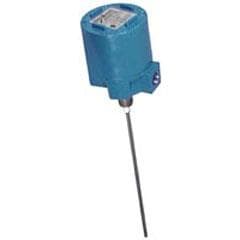Model 103 Capacitance Level Switch
Brand: Delta Controls CorporationCapacitance Level Switch, Integral Mount, SPDT.
The Delta Controls Model 103 probe type level switches use RF Admittance technology to produce switching action when a material level crosses the setpoint of its sensing probe.
Many probe configurations are available. The proper style is determined by the service. The interface position between two liquids with different dielectric constants can be accurately detected by the switches.
The units will even average out a cloudy interface and produce a precise switching action as its position passes the set point. A limitation is that one of the liquids must be nonconductive.
They are not sensitive to SPG (specific gravity) variations. Water/hydrocarbon interfaces produce excellent results.
Detecting a liquid interface as it moves down a pipeline is another useful application.
The Delta Controls Model 103 utilizes admittance technology to measure how much of its sensing probe is covered by the liquid.
This is accomplished by generating a radio frequency pulse of energy which travels from the sensing probe to the ground reference (usually the tank wall).
The amount of liquid between the two determines how much energy is transferred.
The amount of energy flowing (very small and low level in all cases) is a highly repeatable measure of the liquid level or interface position.
The amount is compared to an internal reference and produces a switching action at a selected material elevation.
Integral mounting on the probe head produces a simple one-piece unit which generally results in the lowest installed cost.
Alternately, the Delta Controls Model 105 electronics module may be located up to 50 feet away from the probe. A coaxial cable then connects the remote electronics to the sensing probe.
The level probe may be mounted in any position; vertical, horizontal, or at an angle. Horizontal mounting is usually preferred for alarm action because it provides the sharpest switch point definition.
Features- R.F. Admittance type circuitry
- Insensitive to process coatings and buildup
- Choice of integral or remote electronics module
- Design is accurate, simple, and very reliable
- Ambient temperature range -40 to 185° F (-40 to 85° C)
- Corrosion resistant, NACE #MR-01-75 optional
- Heavy duty sealed contacts
- High or low relay fail-safe action
- Adjustable 1-60 second time delay
- High reliability; 100 hour operational run-in testing
- Epoxy sealed electronics module survives harsh environments and area vibration
- Process pressure may be as high as 10,000 psiG (700 bar)
- Process temperatures may be as high as 1,000° F (550° C) or as low as -360°F (-215°C)
- Choose from application specific probe shapes, styles, configurations, and process connections
- Wide choice of wetted materials includes steel, stainless steel, PTFE, PVDF, Monel, and ceramics
- Threaded, flanged, or bracket mounting
- Sealed relay for corrosive conditions
Specifications
Basic Supply Voltage
- 120 Vac, 24 Vdc Optional
Differential
- Fixed 2 SU for Alarm Service
Electronics Module
- Potted for High Reliability.
Housings
- 4X Hoseproof, Class 1, Div. 1, Groups BCD,EFG Explosion-proof, PVC, Aluminum, or Stainless Steel Material.
Level Range
- Setable Range from 0 to 4,000 Sensing Units (SU) Equivalent Admittance
- Switching at any Point Along the Length of the Level Sensing Probe Selected (See Application Note #PROB-198 for Details)
Operating Temperature
- -40° to +185° F (-40° to +85° C) Ambient
Temperature Effect (0° to 150° F)
- ± 0.25 SU, Typically Less than 1/10” (2 mm) in Water
Time Delay
- 0.25 to 60 seconds Adjustable
